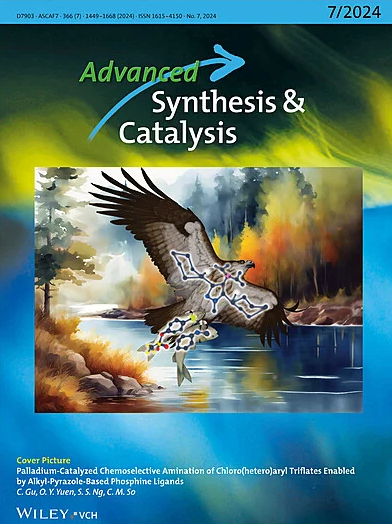共价三嗪骨架的合成研究进展:方法、机理及结晶效果
IF 4
2区 化学
Q2 CHEMISTRY, APPLIED
引用次数: 0
摘要
共价三嗪框架(CTFs)是一类基于三嗪环的氮杂环共价有机框架材料。由于具有高比表面积、可设计的孔隙结构和优异的物理化学性质,它们在催化、气体吸附和能量储存方面具有广阔的应用前景。虽然已经提出了一系列的合成方法,但其合成途径的复杂性、调节结晶度的挑战以及反应机理的模糊性限制了这些材料的精确设计和性能优化。全面了解各种合成方法对于合理调节其结构和性能,以及理解合成机理和结晶效果至关重要。本文系统地概述了CTFs的常用制造方法。此外,还介绍了CTFs的合成机理和提高其结晶度的方法。最后,对合成CTF材料的未来发展进行了展望。这一关键性的综述有望为CTFs的研究提供一个可行的方向。本文章由计算机程序翻译,如有差异,请以英文原文为准。
Recent Advances in Synthesis of Covalent Triazine Frameworks: Methods, Mechanism, and Crystallization Effects
Covalent triazine frameworks (CTFs) are a class of nitrogen‐heterocyclic covalent organic framework materials based on the triazine ring. They show promising applications in catalysis, gas adsorption, and energy storage thanks to their high specific surface area, designable pore structure, and excellent physicochemical properties. Although a series of synthetic methods have been proposed, the complexity of their synthetic pathways, the challenge of regulating crystallinity, and the ambiguity of the reaction mechanism limit the precise design and performance optimization of these materials. A comprehensive understanding of the numerous synthesis methodologies is pivotal for rational modulation of its structure and performance, as well as for understanding the synthesis mechanism and crystallization effects. Herein, the common manufacturing methods of CTFs are systematically outlined. Additionally, the synthesis mechanisms and ways to improve the crystallinity of CTFs are also covered. Finally, some prospects for the future development of synthetic CTF materials are discussed. This critical review is anticipated to offer a viable research direction for CTFs.
求助全文
通过发布文献求助,成功后即可免费获取论文全文。
去求助
来源期刊

Advanced Synthesis & Catalysis
化学-应用化学
CiteScore
9.40
自引率
7.40%
发文量
447
审稿时长
1.8 months
期刊介绍:
Advanced Synthesis & Catalysis (ASC) is the leading primary journal in organic, organometallic, and applied chemistry.
The high impact of ASC can be attributed to the unique focus of the journal, which publishes exciting new results from academic and industrial labs on efficient, practical, and environmentally friendly organic synthesis. While homogeneous, heterogeneous, organic, and enzyme catalysis are key technologies to achieve green synthesis, significant contributions to the same goal by synthesis design, reaction techniques, flow chemistry, and continuous processing, multiphase catalysis, green solvents, catalyst immobilization, and recycling, separation science, and process development are also featured in ASC. The Aims and Scope can be found in the Notice to Authors or on the first page of the table of contents in every issue.
 求助内容:
求助内容: 应助结果提醒方式:
应助结果提醒方式:


